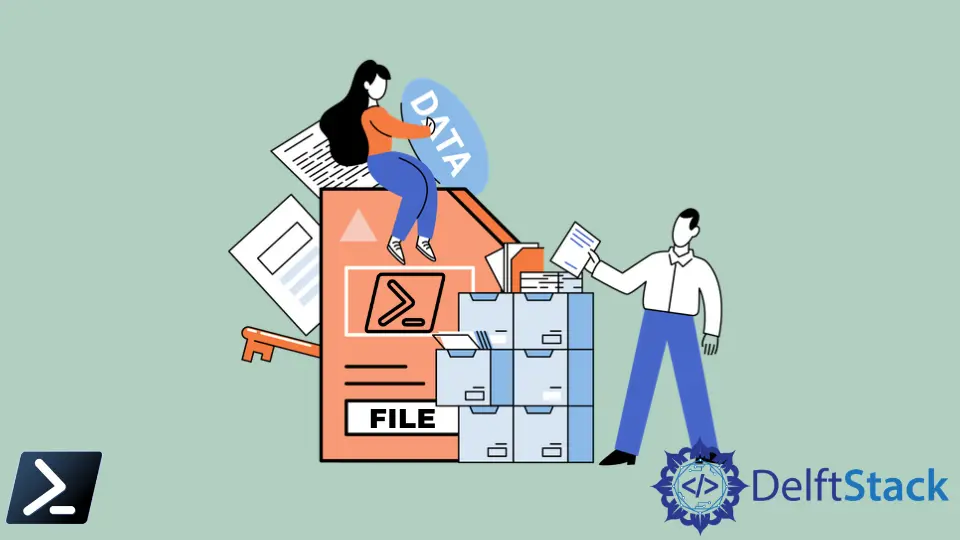Cómo agregar datos a un archivo usando PowerShell
-
la Sintaxis Básica de
Add-Contenten PowerShell -
Usar
Add-Contentpara Agregar Texto a un Archivo en PowerShell - Usar el Operador (`n) para Agregar Datos en una Nueva Línea en PowerShell
-
Usar el Comando
Add-Contentpara Agregar el Contenido de un Archivo a Otro Archivo en PowerShell -
Usar el Comando
Add-Contentpara Agregar Datos a un Archivo de Solo Lectura en PowerShell

El comando Add-Content en PowerShell agrega contenido a un archivo. Podemos especificar contenido en el comando o Get-Content para obtener el contenido del archivo para agregar.
El cmdlet Add-Content agrega texto al archivo o agrega una cadena al archivo.
la Sintaxis Básica de Add-Content en PowerShell
El cmdlet Add-Content en Windows PowerShell agrega contenido al archivo y agrega texto al archivo.
Add-Content
[-Path] <string[]>
[-Value] <Object[]>
[-PassThru]
[-Filter <string>]
[-Include <string[]>]
[-Exclude <string[]>]
[-Force]
[-Credential <pscredential>]
[-WhatIf]
[-Confirm]
[-NoNewline]
[-Encoding <Encoding>]
[-AsByteStream]
[-Stream <string>]
[<CommonParameters>]
Usar Add-Content para Agregar Texto a un Archivo en PowerShell
Por ejemplo, tienes el archivo de texto Get-DateFile.txt en el directorio.
Crea un nuevo archivo con Get-DateFile.txt, y agrega algunos datos de prueba.
Get-DataFile.txt:
Example illustration about appending text to
Add-Content -Path .\Get-DateFile.txt "End of file"
El cmdlet Add-Content agrega la cadena End of file al final del archivo especificado por el parámetro -Path en el directorio actual.
Salida:
Example illustration about appending text to End of file
Usar el Operador (`n) para Agregar Datos en una Nueva Línea en PowerShell
Para agregar datos a un archivo en una nueva línea, usa el operador de nueva línea (`n).
Add-Content -Path .\Get-DateFile.txt "`nSecond line starts here..."
Salida:
Example illustration about appending text to End of file
Second line starts here…
Usar el Comando Add-Content para Agregar el Contenido de un Archivo a Otro Archivo en PowerShell
El comando Add-Content agregará el contenido de un archivo a otro.
Leerá y asignará el contenido del archivo a una variable y escribirá el contenido en el archivo de destino.
El comando Add-Content creará un nuevo archivo si el archivo no existe mientras agrega el texto al archivo.
# Read file contents to variable
$sourceFileContent = Get-Content -Path .\GetFileProperties.txt
# This line will append the content of one file to another file
# If the file does not exist, the Add-Content command will create a new file
Add-Content -Path .\Destination_File.txt -Value $sourceFileContent
Para agregar el contenido de un archivo a otro archivo, el cmdlet Get-Content en PowerShell obtiene el contenido del archivo especificado por el parámetro Path.
Luego, lee el contenido del archivo y lo almacena en una variable $sourceFileContent.
El cmdlet Add-Content en PowerShell agrega el contenido del archivo fuente especificado en el parámetro -Value.
El comando Add-Content creará un nuevo archivo si el archivo no existe y copiará el contenido.
Usar el Comando Add-Content para Agregar Datos a un Archivo de Solo Lectura en PowerShell
# Create a new file
New-Item -Path .\TempROFile.txt -ItemType File
# Set file as read-only
Set-ItemProperty -Path .\TempROFile.txt -Name IsReadOnly -Value $True
# Get file details
Get-ChildItem -Path .\TempROFile.txt
# Appends the line to file
Add-Content -Path .\TempROFile.txt -Value 'End of File' -Force
El primer comando crea un nuevo archivo usando el cmdlet New-Item de PowerShell.
El comando Set-ItemProperty en PowerShell se usa para establecer la propiedad IsReadOnly en verdadero para el archivo especificado.
El comando Get-ChildItem en PowerShell obtiene detalles del archivo especificado como Name, LastWriteTime, Length y mode.
El cmdlet Add-Content agrega una línea a un archivo de solo lectura especificado por el parámetro -Path.
Marion specializes in anything Microsoft-related and always tries to work and apply code in an IT infrastructure.
LinkedIn